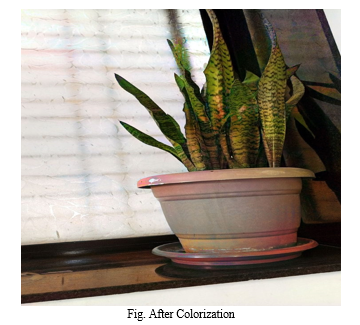Ijraset Journal For Research in Applied Science and Engineering Technology
- Home / Ijraset
- On This Page
- Abstract
- Introduction
- Conclusion
- References
- Copyright
Image Colorization
Authors: Saurabh Sunil Gaikwad, Sanket Nagesh Sonawane, Harshad Abhiman Bansode, Dinesh Datta Jadhav, Suraj Balu Karande, Dr. S. P. Pawar
DOI Link: https://doi.org/10.22214/ijraset.2024.61798
Certificate: View Certificate
Abstract
Image colorization is a complex and challenging task in computer vision, with numerous applications in art, entertainment, restoration, and more. This project aims to develop an automated image colorization system leveraging the power of deep learning techniques. The primary objective is to train a deep neural network model capable of accurately and semantically colorizing grayscale images, reproducing natural and visually appealing colour distributions. Our approach utilizes Convolutional Neural Networks (CNNs) and Generative Adversarial Networks (GANs) to learn the intricate relationships between grayscale images and their corresponding colour versions. The project involves the following key steps: Data Collection and Preprocessing, Model architecture, Training, Evaluation, Application. The project\'s outcome is expected to provide a powerful and versatile tool for automating image colorization tasks, offering high-quality results while preserving the artistic intent of the original images. The fusion of deep learning and computer vision techniques in this project exemplifies the potential for artificial intelligence to revolutionize image processing and creative industries.
Introduction
I. INTRODUCTION
The world is not black and white, yet many historical photographs, classic films, and digital images exist solely in grayscale. The absence of color often limits our ability to fully appreciate and relate to these visual representations. Image colorization, the process of adding lifelike colors to grayscale images, addresses this issue by bringing a new dimension of realism and emotional resonance to visual content.
Historically, manual colorized was the normal, a labor-intensive and time-consuming processes that require skilled artists to painstakingly apply colors to each pixel. However, recent advancements in artificial intelligence and deep learning has ushered in a new era of automation image colorization, making it faster, more accessible, and remarkably accurate?
Colorizeding images is a fascinating field that intersect art and technology, aiming to breath life into historical or black-and-white images by adding color. Through the usage of computer science techniques, particularly deep learning, researchers and enthusiasts has develop algorithm capable of automatically adding color to grayscale images with remarkable accuracy. We delve into the realm of image colorizeding, exploring various methodologies and algorithms used to automate this process. By understanding the underlying principles and implementing these algorithms, we aim to not only gain insights into the intricacies of image processing but also to contribute to the advancement of computer vision techniques.
A. Objective
- User-Friendly Interface: Develop a user-friendly interface that enables individuals, including those without technical expertise, to easily input grayscale images and obtain colorized results.
- Preservation and Restoration: Use the system to contribute to the preservation and restoration of historical and cultural artifacts, photos, and documents by bringing them to life with color.
- Time Efficiency: Create a time-efficient solution that significantly reduces the effort required for manual colorization, particularly for large datasets.
II. LITERATURE SURVEY
- Zhang, W., Zhu, Z., & Wu, Y. (2006) proposed an optimization-based approach to image colorization. They formulated the problem as an energy minimization task, where color constraints and smoothness priors are incorporated to guide the colorization process. Their method achieved impressive results on grayscale images, demonstrating the effectiveness of optimization techniques.
- Levin, A., Lischinski, D., & Weiss, Y. (2004) introduced a pioneering method known as "Colorization by Example." This approach leverages user input to guide the colorization process, allowing users to specify color hints on grayscale images. By propagating these hints through the image using texture synthesis and optimization, the algorithm automatically generates colorized outputs. This method laid the foundation for subsequent research in interactive image colorization.
- Dahl, R., Norouzi, M., & Shlens, J. (2016) proposed Deep Colorization, a deep learning-based approach to image colorization. They trained a convolutional neural network (CNN) on a large dataset of grayscale images paired with their corresponding colored versions. The network learns to predict plausible color distributions given grayscale inputs, achieving state-of-the-art results in automatic image colorization.
- Zhang, R., Isola, P., & Efros, A. A. (2016) introduced the Colorful Image Colorization model, which utilizes a classification-based approach to image colorization. By treating colorization as a classification task, the model predicts the probability distribution of possible colors for each pixel, allowing for diverse and realistic colorizations. The authors demonstrate the effectiveness of their approach on diverse datasets, including natural scenes and artistic images.
- ason Antic (2018) introduced DeOldify, a deep learning-based system for automatic image colorization. DeOldify utilizes a Generative Adversarial Network (GAN) architecture, consisting of a generator network trained to produce colorized images and a discriminator network trained to distinguish between real and generated colorizations. The model learns to produce vibrant and realistic colorizations, particularly on historical and archival images.
- Pooja Aravind Palkar, Aparna Rajaram Patil, Jagruti Sahebrao Patil and Rachana Dhanawat, Colorization of Black and White Images using Deep Learning, Mumbai, India:Department of Computer Science and Technology, SNDT Women’s University. Colorization of black and white images has become increasingly important with the advent of high-quality and high-resolution pictures in modern-day life. This project proposes a method for converting black and white pictures to color pictures. This project is mainly designed for coloring black and white images.
III. METHODOLOGY
A. Data Collection and Preparation
- Grayscale Images: Collect a diverse dataset of grayscale images that represent various styles, subjects, and historical periods. This dataset should be large enough to ensure the model's ability to generalize effectively.
- Color References: Pair each grayscale image with its corresponding color reference image. These references serve as ground truth data for training and evaluation.
- Data Augmentation: Apply data augmentation techniques such as cropping, rotation, and flipping to increase the dataset's diversity and robustness.
B. Data Preprocessing
- Resizing and Normalization: Resize all images to a consistent resolution, typically suitable for the chosen neural network architecture. Normalize pixel values to a common scale (e.g., [0, 1] or [-1, 1]).
- Splitting the Dataset: Divide the dataset into three subsets: training, validation, and testing. The training set is used for model training, the validation set for hyperparameter tuning, and the testing set for final evaluation.
C. Model Architecture
- Design a neural network architecture that can take grayscale images as input and produce colorized images as output.
- Consider using Convolutional Neural Networks (CNNs) as a backbone for feature extraction and potentially incorporate Generative Adversarial Networks (GANs) for generating realistic colorizations.
- Experiment with different architectural choices, including the depth of the network, the number of layers, and the activation functions.
D. Loss Functions
- Define appropriate loss functions to guide the training process. Common loss functions include mean squared error (MSE) for pixel-wise color accuracy and adversarial loss for perceptual realism.
- Balance the trade-off between these loss components to achieve the desired colorization quality.
E. Training
- Train the model using the training dataset. Utilize stochastic gradient descent (SGD) or other optimization algorithms.
- Regularize the model with techniques like dropout or batch normalization to prevent overfitting.
- Monitor training progress, including loss convergence, and make adjustments as necessary.
F. Hyperparameter Tuning
Fine-tune hyperparameters, such as learning rate, batch size, and architectural choices, using the validation dataset to optimize model performance.
G. Evaluation
- Assess the model's performance using various evaluation metrics, including:
- Color Accuracy: Compare colorized images with ground truth references.
- Perceptual Quality: Use perceptual metrics like Structural Similarity Index (SSIM) and Inception Score to measure the quality of generated colorizations.
- Conduct qualitative evaluation by visually inspecting colorized images for artifacts and realism.
- Compare the model's results with existing colorization methods to demonstrate its effectiveness.
H. User Interface (Optional)
- Develop a user-friendly interface that allows users to easily input grayscale images and obtain colorized results.
- Ensure that the interface provides options for customization and user guidance, if desired.
I. Deployment and Application
- Deploy the trained model in the desired application scenarios, such as historical photo restoration, film colorization, or creative artwork enhancement.
- Monitor the model's performance in real-world use and gather user feedback for further improvements.
J. Documentation and Reporting
- Document the entire process, including data collection, preprocessing, model architecture, training, and evaluation.
- Prepare a comprehensive report summarizing the methodology, results, and any insights gained during the project.


Conclusion
A. Conclusion In conclusion, the Image Colorization Project represents a significant step forward in the realm of computer vision and artificial intelligence. This project set out to automate the process of adding lifelike colors to grayscale images, and through the application of deep learning techniques, it has achieved remarkable results. The versatility of this project is evident in its potential applications, ranging from restoring historical photographs to enhancing black-and-white movies, assisting artists in their creative endeavours, and even enabling individuals to effortlessly bring their personal photos to life with vibrant colors. The user-friendly interface developed as part of this project further democratizes image colorization, making it accessible to a wide audience. B. Future Scope 1) Deep Learning Techniques: The core methodology will rely on deep learning techniques, potentially incorporating Convolutional Neural Networks (CNNs) and Generative Adversarial Networks (GANs) to model the relationship between grayscale and color images. 2) Data Collection: The project will involve the collection and preprocessing of a diverse dataset of grayscale images paired with color references. Data augmentation techniques may be applied to increase dataset diversity. 3) Model Development: The design and development of an effective neural network architecture for colorization, including the choice of loss functions and optimization algorithms, will be a central component of the project.
References
[1] T. Welsh, M. Ashikhmin and K. Mueller, \"Transferring color to greyscale images\" in ACM Transactions on Graphics (TOG), ACM, vol. 21, no. 3, pp. 277-280, 2002. [2] Levin, D. Lischinski and Y. Weiss, \"Colorization using optimization\" in ACM transactions on graphics (tog), ACM, vol. 23, no. 3, pp. 689-694, 2004. [3] R. Ironi, D. Cohen-Or and D. Lischinski, \"Colorization by example\", Rendering Techniques, pp. 201-210, 2005. [4] L. Yatziv and G. Sapiro, \"Fast image and video colorization using chrominance blending\", IEEE Transactions on Image Processing, vol. 15, no. 5, pp. 1120-1129, 2006. [5] Z. Cheng, Q. Yang and B. Sheng, \"Deep colorization\", Proceedings of the IEEE International Conference on Computer Vision, pp. 415-423, 2015. [6] G. Larsson, M. Maire and G. Shakhnarovich, Learning representations for automatic colorization, 2016. [7] J. Yoo and S.-Y. Oh, \"A coloring method of gray-level image using neural network\", Proceedings of the 1997 International Conference on Neural Information Processing and Intelligent Information Systems, vol. 2, pp. 1203-1206, 1997. [8] Y. Linde, A. Buzo and R. Gray, \"An algorithm for vector quantizer design\", IEEE Transactions on communications, vol. 28, no. 1, pp. 8495, 1980. [9] T. Kohonen, \"Self-organized formation of topologically correct feature maps\", Biological cybernetics, vol. 43, no. 1, pp. 59-69, 1982. [10] F. Pedregosa, G. Varoquaux, A. Gramfort, V. Michel, B. Thirion, O. Grisel, et al., \"Scikit-learn: Machine learning in Python\", Journal of Machine Learning Research, vol. 12, pp. 2825-2830, 2011. [11] Oliva and A. Torralba, \"Modeling the shape of the scene: A holistic representation of the spatial envelope\", International Journal of Computer Vision, vol. 42, no. 3, pp. 145-175, 2001.
Copyright
Copyright © 2024 Saurabh Sunil Gaikwad, Sanket Nagesh Sonawane, Harshad Abhiman Bansode, Dinesh Datta Jadhav, Suraj Balu Karande, Dr. S. P. Pawar. This is an open access article distributed under the Creative Commons Attribution License, which permits unrestricted use, distribution, and reproduction in any medium, provided the original work is properly cited.

Download Paper
Paper Id : IJRASET61798
Publish Date : 2024-05-08
ISSN : 2321-9653
Publisher Name : IJRASET
DOI Link : Click Here
 Submit Paper Online
Submit Paper Online

